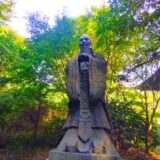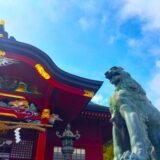【Senso-ji Temple summary】
Sensoji Temple is the oldest temple in Tokyo, officially known as Kinryuzan Sensoji Temple. The main deity is the Bodhisattva Sho-Kannon, known to many people in Japan and abroad as the Asakusa Kannon. The world-famous “Kaminarimon,” or Thunder Gate, at the entrance to the main approach to the temple, is the oldest temple in Tokyo with a history of approximately 1,400 years. The main deity is the Bodhisattva Sho-Kannon. Tokugawa Ieyasu designated this temple as a place of prayer for the Tokugawa Shogunate, and the number of worshippers increased rapidly during the Edo period (1603-1867), resulting in the creation of the Nakamise (a traditional shopping street), which became crowded with visitors.
【Senso-ji Temple Kaminari-mon Gate】
![Senso-ji Temple [Tokyo] 22139032 m 1 1024x777 - Senso-ji Temple [Tokyo]](https://japan-shrine.info/wp-content/uploads/22139032_m-1-1024x777.jpg)
Kaminarimon, officially called “Wind and Lightning Gate,” is famous for the large red lanterns hung between the gates, which Japanese people have probably seen at least once. The Kaminarimon was destroyed by a fire called the Tawaramachi Fire, but was rebuilt in 1960 with a donation from Konosuke Matsushita, the founder of Matsushita Electric Industrial Company.
![Senso-ji Temple [Tokyo] 27325282 m 1024x683 - Senso-ji Temple [Tokyo]](https://japan-shrine.info/wp-content/uploads/27325282_m-1024x683.jpg)
The dragon carving under the large lantern is magnificent, so be sure to look up at it when you visit the temple.
【Senso-ji Temple Hozo-mon Gate】
![Senso-ji Temple [Tokyo] 22769417 m 1024x683 - Senso-ji Temple [Tokyo]](https://japan-shrine.info/wp-content/uploads/22769417_m-1024x683.jpg)
Passing through the Kaminarimon gate and continuing down the Nakamise, you will see the Hozomon gate and the five-story pagoda. The Hozomon gate was destroyed by fire along with the Kannondō Hall, five-story pagoda, and sutra library in the Tokyo Air Raid of 1945, and was rebuilt in 1964 with reinforced concrete and tile roofing, with contributions from Mr. Yonetaro Otani, president of Otani Heavy Industries, and his wife. It was also called “Niomon” because of the Niomon statues on both sides, but it was renamed “Hozomon” from “Niomon” to “Hozomon” because it also serves as a sutra repository and houses the sutras and treasures of the temple.
【Senso-ji Temple five-storied pagoda】
![Senso-ji Temple [Tokyo] image - Senso-ji Temple [Tokyo]](https://japan-shrine.info/wp-content/uploads/image.jpeg)
The five-story pagoda of Sensoji Temple was built in 942, the same year as the Sensoji Main Hall, Kaminarimon (Thunder Gate), and Hozomon (Treasure House Gate), by Taira no Kinmasa, a Musashi (guardian of the Imperial household). Since its construction, the temple was repeatedly destroyed by fire and rebuilt, until it was destroyed by fire in the war in 1945. It was rebuilt in 1973 using steel-framed reinforced concrete. The pagoda has a hall where 100 statues of the Holy Avalokitesvara Bodhisattva are enshrined, as well as 12,000 memorial tablets for perpetual memorial services that have been donated by the congregation. At 53.32 m above the ground (48.3 m for the tower only), it is the second tallest five-story pagoda after To-ji Temple in Kyoto.
![Senso-ji Temple [Tokyo] DSC 0684 160x160 - Senso-ji Temple [Tokyo]](https://japan-shrine.info/wp-content/uploads/DSC_0684-160x160.jpg) Toji Temple and Yashima Shrine Pavilion [Kyoto]
Toji Temple and Yashima Shrine Pavilion [Kyoto]
【Senso-ji Temple nave】
![Senso-ji Temple [Tokyo] 29914029 m 1024x576 - Senso-ji Temple [Tokyo]](https://japan-shrine.info/wp-content/uploads/29914029_m-1024x576.jpg)
The main hall, also called Kannon-do, was built in 645 and destroyed by fire during the Tokyo Air Raid of 1945, but was rebuilt in 1958 with funds donated by believers from all over Japan. The current main building is a modern reinforced concrete structure with titanium roof tiles.
【Senso-ji Temple night view】
At night, it is illuminated, creating a fantastic atmosphere that differs from that during the day.
![Senso-ji Temple [Tokyo] 2090881 m 1024x726 - Senso-ji Temple [Tokyo]](https://japan-shrine.info/wp-content/uploads/2090881_m-1024x726.jpg)
As one of the most popular tourist destinations in Japan, Hatsumode is visited by a large number of worshippers every year. Since it is one of the top 10 most popular tourist destinations in Japan, the best time to visit the shrine is early morning on weekdays (8:00 – 9:00). Also, the night time when the shrine is illuminated (sunset to 23:00) is a good time to enjoy the atmosphere because the Nakamise is closed and there are fewer people.
【Senso-ji Temple Access】
Manager’s Comments
Many of the buildings have been designated as national important cultural properties, and visitors can feel the history and tradition of the temple. Visitors can also draw fortunes and choose from a variety of colorful good luck charms. There are many souvenir stores and restaurants in the area, as well as kimono and rickshaw rentals, making it a great place for tourists with money to spend. Because it is a famous tourist spot, there are many tourists during the daytime, so it is not a place where you can enjoy visiting Buddhist temples and shrines. For better or worse, it is a commercialized tourist spot, so it is up to each person to enjoy it in his or her own way. If you don’t like crowds, this is not the place for you, but I recommend you to visit at least once.
2-3-1 Asakusa, Taito-ku, Tokyo 111-0032, Japan
※No parking is available. Use nearby parking.
 Tour of Japanese shrines and temples
Tour of Japanese shrines and temples 

![Senso-ji Temple [Tokyo] DSC 0454 1 150x150 - Senso-ji Temple [Tokyo]](https://japan-shrine.info/wp-content/uploads/DSC_0454-1-150x150.jpg)
![Senso-ji Temple [Tokyo] DSC 0566 150x150 - Senso-ji Temple [Tokyo]](https://japan-shrine.info/wp-content/uploads/DSC_0566-150x150.jpg)
![Senso-ji Temple [Tokyo] DSC 2299 1 150x150 - Senso-ji Temple [Tokyo]](https://japan-shrine.info/wp-content/uploads/DSC_2299-1-150x150.jpg)
![Senso-ji Temple [Tokyo] DSC 2266 1 150x150 - Senso-ji Temple [Tokyo]](https://japan-shrine.info/wp-content/uploads/DSC_2266-1-150x150.jpg)

